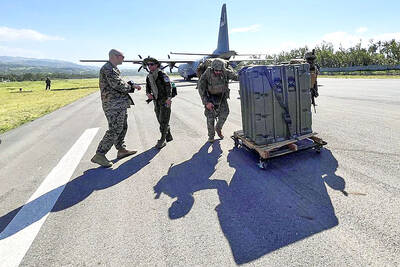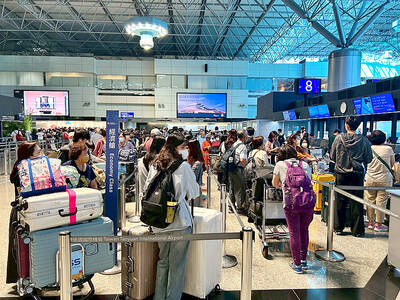The Environmental Protection Administration (EPA) on Tuesday said that it is exploring more diverse methods of refuse disposal, such as establishing five biofuel-fired power generators by 2024.
Last year, the nation produced 9.31 million tonnes of trash — including items not yet sorted for recycling — with 900,000 tonnes, or 31 percent, of trash sent to incinerators, EPA statistics showed.
If a way could be found to prevent the 900,000 tonnes from being sent to incinerators, it would greatly extend the service life of the incinerators, Bureau of Environmental Inspection Technical Supervisor Lin Tso-hsiang (林佐祥) said.
The EPA is examining other methods for diversifying the processing of refuse — most of which is uncooked food — and kitchen scraps, such as running it through dehydrators and then composting it, Lin added.
The bad smell is due to refuse being 85 percent water, Lin said, adding that dehydration can reduce the water content to 70 percent.
Composting machines could greatly shorten the time needed to turn refuse into compost, Lin said.
“Composted refuse takes up less room and smells better,” he added.
More than half of all recycled refuse is composted, he added.
Using compost, the flower trade in Hsinchu County’s Jhushan Township (竹山) has seen a substantial increase in its monthly yield of flowers, allowing it to gift the extra flowers to organizations or the township, he said.
Taichung has a biofuel plant, and the EPA plans to build biofuel plants in Taipei, New Taipei City, Taoyuan and Kaohsiung, he added.
Once all five plants are on the power grid, Taiwan could handle an additional 230,000 tonnes of refuse per year, while generating 41.97 million kilowatt-hours of power per year, Lin said.
The electricity generated could power 11,000 households for an entire year and the power plants could earn NT$214.79 million (US$7.27 million) from selling excess power, Lin said, adding that generating power from biofuel would reduce carbon emissions by 22,200 tonnes per year.
In other news, the EPA is encouraging the public to use a new app that shows the location of the nearest public drinking fountain, with the aim of reducing the use of bottled water.
The Water Refill Map, or Offer Tea (奉茶) in Chinese, is available on iOS and Android, and provides information on drinking fountains installed by government agencies and local businesses, the agency said on Wednesday.
The app, which was launched a few months ago, shows more than 6,000 drinking fountains throughout Taiwan, it said, adding that the number is expected to double by the end of this year.
The app would show more public drinking fountains nationwide than there are convenience stores, the agency said.
The goal is to reduce the use of bottled water in Taiwan, where consumption averages 1 billion bottles per year, EPA Deputy Minister Tsai Hung-teh (蔡鴻德) said, adding that lining up that many plastic bottles end to end would encircle the Earth 5.7 times.
Although Taiwan does a good job of recycling, there is still a lot of plastic pollution in the environment, Tsai said, adding that reducing the use of plastic bottles would help lower energy consumption and carbon emissions from fossil fuels.
CircuPlus, the company that developed the app, said that it has a function that allows users to report any issues with a drinking fountain’s water quality.

Three batches of banana sauce imported from the Philippines were intercepted at the border after they were found to contain the banned industrial dye Orange G, the Food and Drug Administration (FDA) said yesterday. From today through Sept. 2 next year, all seasoning sauces from the Philippines are to be subject to the FDA’s strictest border inspection, meaning 100 percent testing for illegal dyes before entry is allowed, it said in a statement. Orange G is an industrial coloring agent that is not permitted for food use in Taiwan or internationally, said Cheng Wei-chih (鄭維智), head of the FDA’s Northern Center for

The Chinese military has built landing bridge ships designed to expand its amphibious options for a potential assault on Taiwan, but their combat effectiveness is limited due to their high vulnerability, a defense expert said in an analysis published on Monday. Shen Ming-shih (沈明室), a research fellow at the Institute for National Defense and Security Research, said that the deployment of such vessels as part of the Chinese People’s Liberation Army (PLA) Navy’s East Sea Fleet signals a strong focus on Taiwan. However, the ships are highly vulnerable to precision strikes, which means they could be destroyed before they achieve their intended

LOOKING NORTH: The base would enhance the military’s awareness of activities in the Bashi Channel, which China Coast Guard ships have been frequenting, an expert said The Philippine Navy on Thursday last week inaugurated a forward operating base in the country’s northern most province of Batanes, which at 185km from Taiwan would be strategically important in a military conflict in the Taiwan Strait. The Philippine Daily Inquirer quoted Northern Luzon Command Commander Lieutenant General Fernyl Buca as saying that the base in Mahatao would bolster the country’s northern defenses and response capabilities. The base is also a response to the “irregular presence this month of armed” of China Coast Guard vessels frequenting the Bashi Channel in the Luzon Strait just south of Taiwan, the paper reported, citing a

About 4.2 million tourist arrivals were recorded in the first half of this year, a 10 percent increase from the same period last year, the Tourism Administration said yesterday. The growth continues to be consistent, with the fourth quarter of this year expected to be the peak in Taiwan, the agency said, adding that it plans to promote Taiwan overseas via partnerships and major events. From January to June, 9.14 million international departures were recorded from Taiwan, an 11 percent increase from the same period last year, with 3.3 million headed for Japan, 1.52 million for China and 832,962 to South Korea,